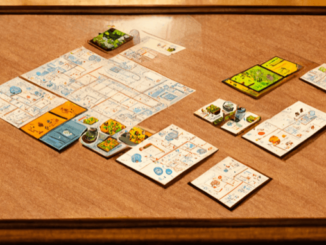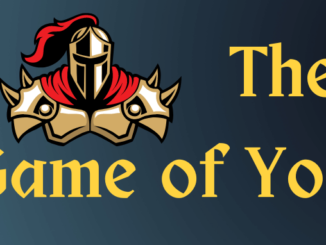
The idea of the ‘Magic Circle’ was first put forward by Johan Huizinga in ‘Homo Ludens’ (trans. Man the Player) in 1938.
Homo Ludens is available from Amazon
Alongside his thesis that play is primary too and necessary for the creation of culture, Huizinga posited that:
- Play is not “ordinary” or “real” life.
- Play is free, and is, in fact, freedom.
- Play is distinct from “ordinary” life both as to locality and duration.
- Play creates order, is order. Play demands order absolute and supreme.
- Play is connected with no material interest, and no profit can be gained from it
Characteristics 2 and 3 are most relevant to the Magic Circle. The ‘Magic Circle’ is a special space in which games play occurs. It protects the real world from the game world and vice versa, but it is porous. Elements of the real world can penetrate the game and the play can also leak into the real world. Perhaps this flexing of the membrane between the real and game worlds can be seen most markedly in applications like Augmented Reality and games like Pokemon Go.
Creating Separate Spaces

It is a space in which the game or play takes place. In some cases, this is an actual special physical space, as if often the case with sports. Quite often it occurs when a space which is normally used for ‘real world’ activities is modified in some way; when you open a board game and set it up on your kitchen table, for example. But it can just be a ‘space’ which is created in the imagination, a state of mind which does not require you to ‘go’ anywhere special, but which nevertheless is cognitively and maybe emotionally distinct from the ‘normal’ world.
The Magic Circle is also a social contract. When a player enters the magic circle, they agree to abide by the rules of the different reality they are stepping into. This includes not only the specific rules of the game itself, but also the obligations and etiquette of being in a magic circle at all. This might include concepts such as sportmanship and fair play, and ‘staying in character’ if you are playing a role-playing game.
Implications of the Magic Circle
There are implications of these characteristics, for both magic circles which are created by design, and for how we characterise activities and locations as playful.
Because the magic circle is different from ‘normal life’, a designed magic circle can often benefit from clear signposting, or even from having tangible physical boundaries. Sports fields have already been mentioned, but game boards or special equipment or pieces, can all do the same job. Not all of these necessarily have to be ‘designed’ as part of the work of a game designer. Players themselves can ‘create a mood’ through rituals, or environmental adjustments like different lighting or putting on music.
As a designer, you can consider how the effect of the magic circle could be enhanced, by the game components, through the rules or by suggestions to players as how they could play.
Consider the permeability of the magic circle. Is that something you wish to enhance or do you want to insulate the two worlds more emphatically. Reasons for doing this might include wanting to ensure that ‘limitations’ of reality do not contaminate what is happening in the game world. Reasons for increasing the permeability might include bringing the advantage of play into ‘reality’, including creativity and innovation.
A Social Contract

The social contract aspect of the magic circle can be very useful for disrupting existing hierarchies, or for establishing in-game etiquette which can mitigate aspects of real world situations and dynamics that you want to leave behind. Lego® Serious Play® does this by insisting that all questions should be mediated through the models rather than questioning individuals, which can help to defuse situations of potential conflict.
As a designer, consider the aspects of the social contract players enter into when playing your games. How do they affect player dynamics? Will this be taken outside of the game through permeability? How does it facilitate the possibilities for playing ‘what-if’ with social aspects such as hierarchies, relationships and rules of engagement?
The Magic Circle beyond Games
But are ‘magic circles’ only found in games and play, or does it mean that if you enter a magic circle, that the activity you are taking part in is, in some way, playful?
We could be said to be entering and utilising magic circles, every time we enter any ‘space’ with a specific set of ‘rules’ – such as ritual or ceremonial situations, or each time we impose rules upon ourselves – for example, not using bad language in front of one’s parents or children. Some of these situations don’t feel very ‘playful’, quite the opposite in fact, and yet if we return to the middle three of Huizinga’s characteristics, they seem to fit these situations quite well.
When we use the word ‘playful’ in ordinary language, we very often mean ‘enjoyable’. But does play have to be enjoyable?
If not, then these examples could definitely be seen as ‘magic circles’. So, is it the ‘rules’, the playing of a ‘part’ with specific constraints that decides whether or not we are in a magic circle? I believe it is.
Where does ‘Reality’ Begin and End?

The implication of this is that we can bring a greater degree of awareness to these transitions between the ‘real world’ and the various magic circles we inhabit and use. Indeed, there is also need for reflection on what constitutes ‘real life’ at all. If the different roles we play in life, child, parent, employee, friend, all come with their own rules, then maybe our real life is just a collection of overlapping ‘magic circles’ . When do we ever exit, and enter ‘real life’?
Which also raises the question of choice. One of the important aspects of the ‘game’ version of the magic circle is that it is entered voluntarily, when we decide to play. Although it may seem that some of these ‘non-game’ circles are not voluntary, we do have choices. The very fact that the boundaries exist, mean that we could choose not to enter. We can, and sometimes do choose not to ‘play the game’ in certain circumstances. But the consequences for that are often harsh – recognising the severity of breaching social contracts. For example, witness the scolding that people receive in social media when they act in ways which upset the way ‘things should be’, leaving a job in an incendiary way, cutting ties with family, and so on.
The case for Transient Magic Circles
The ‘games-based’ magic circle can last for an extended period of time, when, for example, playing a lengthy game or during a sports match. However, games and play can be much more transient. Each time we play ‘what-if’, skew ‘reality’ in some way, or even tell a joke, we enter a magic circle of sorts, if only for a few seconds.
Take an example where play is unplanned, but emerges from conversation, resulting in a temporary ‘alternate reality’. Two people, out for a walk spot another walker who is exercising three Chihuauas. One walker comments to the other that the dogs used to be Great Danes but they’ve been walked so far, that they’ve worn away. A short jokey conversation ensues where both ‘play with’ the idea that animals, and indeed people, can be ‘worn away’ by too much exercise. This kind of extrapolation of a small ‘difference’ in the way reality works, can be utilised in jokes, to skew our expectations, before a punchline, but can also be extended into full-blown works of art. This is exactly how ‘worldbuilding’ speculative fiction works – by asking ‘what-if’ about a small detail and building a world where that detail works.
You Have Choices

The initial comment in this case was an invitation into a magic circle, and as such it could have been accepted or declined. This may happen numerous times every day, and sometimes you will decide to play, other times you won’t. This may depend on your mood at that particular moment, or it may be because the particular invitation isn’t something you want to explore. The example given above is pretty funny and innocuous, but remember that ‘play’ doesn’t necessarily mean ‘fun’, and sometimes the ‘magic circles’ you get invited to might not be to your taste, or may even make you feel uncomfortable or unsafe.
For example, you may be invited to participate in a magic circle, with rules about your role within it, that you are not prepared to accept. How many times have you heard the protestation ‘I’m not playing their game’, about a power dynamic within the workplace or even a joke where someone considers the humour in poor taste.
The Magic Circle and Learning
As games designers and learning designers, there are three things we are either already doing or could be doing to make use of these concepts to create and enhance experiences.
First, we explicitly and deliberately design magic circles. I won’t go into this in too much detail, because plenty of other writers have already done so. But as an example, Lego® Serious Play® is a really good example of a quite rigid magic circle where expectations are very well defined. This means that there are specific things that you can always expect from an LSP magic circle, which make it especially appropriate for specific applications. This is where you want to facilitate a group of people to discover and process information that they individually and collectively share, while at the same time; ensuring that all get an equal chance to be heard, defusing possible tensions, ‘flattening’ hierarchies and the power dynamics which come with them, and allowing issues to be viewed through the lens of metaphor, rather than directly.
What we may not already be doing is facilitating others to create, use, and then dismantle their own magic circles, to further their own learning, and for the simple fun of it. Games-based learning, if it is done well, is a considerable improvement on what has gone before in terms of learning design. But if we limit it to providing games for others to play, then we are risking it just being another method for ‘delivery’ of content or skills practice.
Games Design as a Pedagogy

Maybe it is now time for games-based learning 2.0, and indeed many designers and facilitators are now turning to games design itself as a pedagogy. This is the playful equivalent of the idea that one learns most by teaching another. If we invite learners to design games about the knowledge, skills or values they are learning, they will be required, not only to deeply explore that domain, but will also use valuable transversal competencies along the way – design thinking, systems thinking, critical thinking, creativity, etc.
This may sound complex, time-consuming and expensive, or learning designers may feel they lack the skills to implement this for their learners. But if we return to some of the ideas discussed above, we can see that magic circles can be transient, and that the only requirement to create one is a simple invitation.
By all means, design a semester-long games design project for your learners, if you have the resources, and it fits your desired outcomes, but, also, consider what you might achieve if the ‘games design’ your learners undertake is nothing more than invitations to each other to briefly play ‘what-if’.
Which brings me to my third point. There is great value to be had by letting learners ‘in on the secret’ and discussing with them the nature and potential of magic circles. Indeed, this is probably the easiest ways to implement the ‘games design’ technique mentioned above. It may seem obvious to you if you play games a lot or use them a lot in your learning, but some of the concepts around magic circles may be difficult for some. Specifically, people may have problems understanding, and working with, the voluntary nature of engagement and the fact that as a ‘constructed fiction’ with its own rules, literally ‘anything goes’ inside the circle.
A Creator’s Responsibility towards ‘Reality’
As an example, let’s look at the magic circle of a recently popular Netflix show ‘Bridgerton’. Many people have been critical that the show does not present the ‘reality’ of Regency England. Putting aside the potential motives to their objections to seeing people of colour portraying members of the aristocracy, this shows a complete misunderstanding of the magic circle they have been invited into. There is no ‘reality’ of Bridgerton, because it is a work of fiction. The writer has not set out to make a historical documentary depicting real events, and they have no responsibility to make historical accuracy a priority in their work. The characters could be using mobile phones and Googling Debretts and it would make no difference to what Bridgerton is.
But it does, obviously, make a difference to whether (some) people are willing to accept the invitation to enjoy this alternate Regency reality. Anyone who has implemented a ‘simulation’ in a learning setting has probably come across similar objections. Couching your response to these objections in terms of a designed magic circle may help learners to understand why some characteristics of the simulated reality have made it into your magic circle and why others have not.
Making a Porous Circle

Similarly, drawing attention to the fact that accepting the invitation, or not, is a voluntary act, is also useful. Make it clear that the rules do apply, inside the circle, but that not entering, or indeed leaving the circle is also an option. You will need to ensure that the boundaries between the circles you (or your learners) create and facilitate, are appropriately porous, but there are valuable learnings to be taken from doing so.
Not only do you ensure that play in your learning setting, is actually truly play, but you receive valuable feedback about the aspects of your circle which people are willing to engage with and those they are not, and get a whole extra meta-layer of material for reflection.
- James Bore – The Ransomeware Game - 13th February 2024
- Ipsodeckso – Risky Business - 23rd January 2024
- Review – Luma World Games - 15th December 2023





Be the first to comment